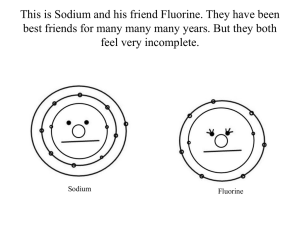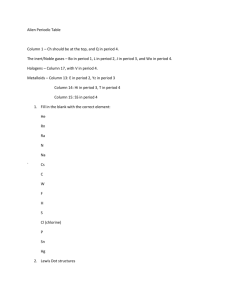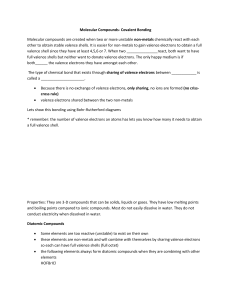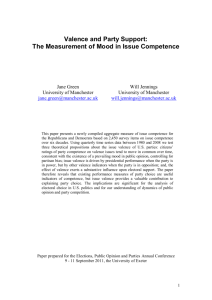AP Computer Science - Final Exam Review
advertisement
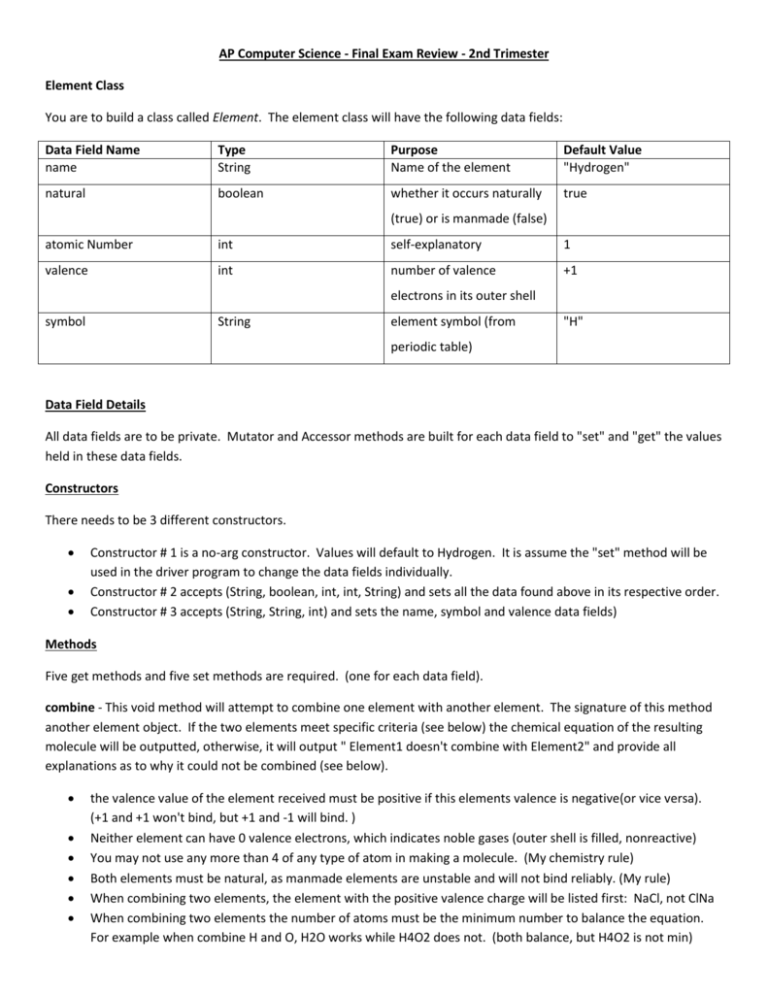
AP Computer Science - Final Exam Review - 2nd Trimester Element Class You are to build a class called Element. The element class will have the following data fields: Data Field Name name Type String Purpose Name of the element Default Value "Hydrogen" natural boolean whether it occurs naturally true (true) or is manmade (false) atomic Number int self-explanatory 1 valence int number of valence +1 electrons in its outer shell symbol String element symbol (from "H" periodic table) Data Field Details All data fields are to be private. Mutator and Accessor methods are built for each data field to "set" and "get" the values held in these data fields. Constructors There needs to be 3 different constructors. Constructor # 1 is a no-arg constructor. Values will default to Hydrogen. It is assume the "set" method will be used in the driver program to change the data fields individually. Constructor # 2 accepts (String, boolean, int, int, String) and sets all the data found above in its respective order. Constructor # 3 accepts (String, String, int) and sets the name, symbol and valence data fields) Methods Five get methods and five set methods are required. (one for each data field). combine - This void method will attempt to combine one element with another element. The signature of this method another element object. If the two elements meet specific criteria (see below) the chemical equation of the resulting molecule will be outputted, otherwise, it will output " Element1 doesn't combine with Element2" and provide all explanations as to why it could not be combined (see below). the valence value of the element received must be positive if this elements valence is negative(or vice versa). (+1 and +1 won't bind, but +1 and -1 will bind. ) Neither element can have 0 valence electrons, which indicates noble gases (outer shell is filled, nonreactive) You may not use any more than 4 of any type of atom in making a molecule. (My chemistry rule) Both elements must be natural, as manmade elements are unstable and will not bind reliably. (My rule) When combining two elements, the element with the positive valence charge will be listed first: NaCl, not ClNa When combining two elements the number of atoms must be the minimum number to balance the equation. For example when combine H and O, H2O works while H4O2 does not. (both balance, but H4O2 is not min) The combination of negative and positive charges must be able to combine to reach 0. You may use several atoms of one element type to achieve this. Here are several examples: o Hydrogen has a valence value of 1. Oxygen has a valence value of -2. The combine method output H2O since 2 Hydrogen and 1 Oxygen atom to form this particular molecule. *Note the number of atoms used follows the element. (H2O means 2 Hydrogen, not 2 Oxygen atoms) o Aluminum (+3) and Lithium (+1) would not combine because both have a positive valence value. o Fluorine (-1) and Nitrogen (+5) would not combine because it would take 5 Fluorine atoms to balance the equation and max atoms is 4. o Sulfur (S)(-2) and Silver (Ag) (+3) would combine to form Ag2S3. Reasons for not combining include: (This must be included as part of the combine method, all that apply) o Both valence charges have same polarity. o One or more elements is a noble gas. o Molecule would require more than four atoms of one element. o One or more elements is man-made. Element Assumed Values Element Hydrogen Helium Boron Carbon Nitrogen Oxygen Fluorine Sodium Silicon Manganese Silver Gold Radon Einsteinium Copernicium Natural true true true true true true true true true true true true true false false Atomic # 1 2 5 6 7 8 9 11 13 25 47 79 88 99 112 Sample ElementDriver Class Element h = new Element(); Element o = new Element("Oxygen", true, 8, -2, "O"); o.combine(h); Element s = new Element("Sodium", "Na", 1); Element c = new Element("Copernicium", false, 112, 2, "Cn"); s.combine(c); Sample Output: Oxygen combines with Hydrogen to form H2O Sodium doesn't combine with Copernicium: Both valence charges have same polarity. One or more elements is man-made. Valence Charge +1 0 -3 +4 +5 -2 -1 +1 -4 +7 +3 -6 0 -4 +2 Symbol H He B C N O F Na Si Mn Ag Au Rn Es Cn




